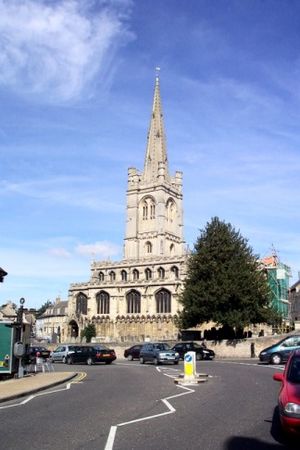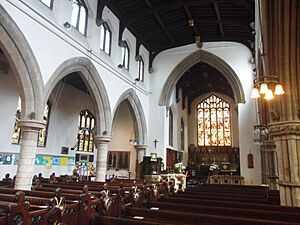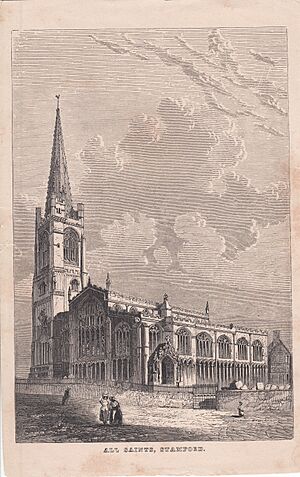All Saints' Church, Stamford facts for kids
Quick facts for kids All Saints' Church, Stamford |
|
|---|---|

All Saints' Church, Stamford
|
|
| 52°39′08″N 00°28′52″W / 52.65222°N 0.48111°W | |
| Denomination | Church of England |
| Churchmanship | Broad Church |
| History | |
| Dedication | All Saints |
| Administration | |
| Parish | Stamford All Saints with St John the Baptist |
| Deanery | Stamford |
| Archdeaconry | Boston |
| Diocese | Diocese of Lincoln |
| Province | Province of Canterbury |
All Saints' Church, Stamford is a historic parish church located in Stamford, Lincolnshire, England. It is part of the Church of England. This church is considered a very important building, which is why it has a special status called a Grade I listed building. You can find it on the north side of Red Lion Square. This square used to be part of the main A1 road until a new bypass was built around Stamford in 1960.
Contents
History of All Saints' Church
A church in Stamford was first mentioned in the Domesday Book. This was a very old survey of England completed in 1086. However, none of that original church building still exists today. There are only a few small pieces of stone from the 1100s. Most of the church you see now was built in the 1200s.
One interesting feature from the 1200s is the exterior blind arcading. This means there are decorative arches on the outside walls. They look like windows or doorways but are actually solid. This kind of decoration is quite unusual for a local church.
The Browne Family's Contributions
Many parts of the church were added and improved in the 1400s. This work was funded by the wealthy Browne family. John Browne, who was a successful merchant, paid for much of the construction during the 1400s. His son, William Browne, also a merchant, paid for and built the church's tall steeple.
The Browne family members are the only people buried inside the church itself. The work done in the late 1400s is known for its "considerable inventiveness." This means it used many creative architectural details, like fancy decorative battlements on the roof.
Later Years
A famous person named William Stukeley was the vicar (a type of priest) at All Saints' Church from 1730 to 1747. The church's parish also includes St John the Baptist's Church. St John's Church was no longer used for regular services starting in 2003.
The Church Organ
All Saints' Church has a large organ. The original organ was built in 1890 by a company called William Hill & Sons. It was later rebuilt and improved in 1916 by another company, James Jepson Binns.



